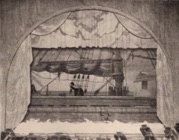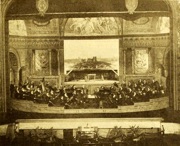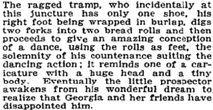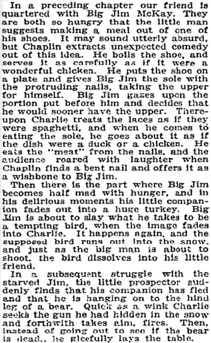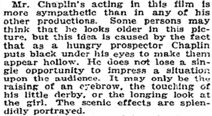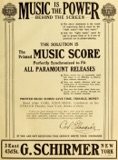The Gold Rush 1923 1924 1926 next previous
The Gold Rush Clippings 228/363
Mordaunt Hall, New York Times, N. Y., August 17, 1925.
Carl Edouarde, musical director, who also celebrates
his eleventh anniversary this year.
(...) Photo, Tenth Anniversary at Mark „Strand“,
Exhibitors Trade Review, April 18, 1925
& MUSIC IS THE POWER BEHIND THE SCREEN (...)
The Solution Is The Printed
MUSIC SCORE (...)
Read what Carl Edouarde, Conductor at the Strand Theatre,
New York, thinks of them.
It gives me great pleasure to state that I have used
the musical scores of the Paramount Feature Films with
marked success, and find them admirably adapted
and practically arranged for the orchestras to be found
in theatres of the average exhibitor.
G. SCHIRMER New York
(...) Moving Picture World, July 15, 1916
& Strand, exterior by night, marquee DOUGLAS FAIRBANKS
The Three Musketeers, New York
(...) Motion Picture News, Sept. 10, 1921
& Strand, lobby, New York
(...) Photo, Motion Picture News, Nov. 17, 1928
& Strand, stage setting with organ beneath orchestra, New York
– New York‘s Strand Theatre‘s Setting for The Better ‘Ole,
Distributed by World Film.
(...) Photo, Moving Picture World, March 8, 1919
& Strand, stage setting, New York
– Hurricane‘s Gal, First National attraction of colorful content matter, was effectively presented at the New York Strand.
(...) Photo, Exhibitors Herald, Aug. 19, 1922
„It was a proud night for Chaplin“
Editorial content. „Charlie Chaplin´s New Comedy.“ (...)
„The great host of spectators that attended the midnight
presentation on Saturday at the Mark Strand of Charlie
Chaplin‘s delightful comedy, The Gold Rush, was convincing
proof that a large contingent of New Yorkers is never
too tired or too hot to laugh. Quite a number of persons in the
interesting gathering had deserted the cool of the
country and not a few of them had already been to one show
that night.
Just before the curtain went up on the prologue
there was a wave of applause and people stood up behold
the little film fun-maker struggling along the aisle,
greeting old friends and being introduced to scores of people.
He was a little nervous and appeared to be much
relieved when he reached his seat in the body of the theatre.
No sooner were the lights switched on after the finish
of the picture – at twenty minutes past 2 o‘clock yesterday
morning – than the enthusiastic assembly appealed
vociferously for a speech from the author-actor, and Mr. Chaplin,
escorted by two friends, went to the stage and thanked
the audience, ending his brief talk by saying that he was very
emotional.
It was a proud night for Chaplin, as while he sat
looking at the picture and listening to Carl Edouarde´s orchestra
he was not insensible to the chuckles und shrieks
of laughter provoked by his own antics on the screen. The joy
of the spectators testified to the worth of the picture,
on which he had worked for more than eighteen months.
There is more than mere laughter in The Gold Rush. Back
of it, masked by ludicrous situations, is something of
the comedian‘s early life – the hungry days in London, the times
when he was depressed by disappointments, the hopes,
his loneliness and the adulation he felt for successful actors.
It is told with a background of the Klondike, and one
can only appreciate the true meaning of some of the incidents
by translating them mentally from the various plights
in which the pathetic little Lone Prospector continually finds
himself. It is as much a dramatic story as a comedy.
Throughout this effort there runs a love story, and one
is often moved to mirth with a lump in one‘s throat.
Chaplin takes strange situations and stirs up tears and smiles.
He accomplishes this with art and simplicity, and in his
more boisterous moments he engineers incidents that at this
presentation provoked shrieks of laughter. You may
analyze some of them and think them absurd. They are, but
it does not alter the fact that you find yourself stirred
by the story, gripped by its swing and filled with compassion
for the pathetic little hero. You forget the ridiculous
garb of the Lone Prospector and he grows upon you as
something real.
Chaplin obtains the maximum effect out of every scene,
and a fine example of this is where he stands with
his back to the audience. He is watching the throng in a
Klondike dancing hall, his little derby, his big shoes
and his cane. He is lonely, and with a hunch of the shoulders
and a gesture of his left hand he tells more than many
a player can do with his eyes and mouth. He is just thinking
of the girl Georgia, the dancing hall queen, who is
not even conscious of the presence of the little man who
adores her.
Later Georgia and some other girls visit the funny little
tramp in his comfortless shack. She learns that this
strange little person loves her when she finds a torn photograph
of herself and a faded rose under the pillow of his bunk.
Georgia and her friends, in a mocking way, chat with the Lone
Prospector, but to his great joy they agree to be his
guests at supper on New Year‘s Eve in the shack. He is in such
an ecstasy of delight when they leave that he leaps
about the tiny place, hurling pillows into the air and literally
making the feathers fly. He sobers down when
Georgia returns for her gloves, but is oblivious to his ridiculous
appearance. His life is one of ups and downs, but
he goes forth with a will to earn what he can to make his
New Year‘s Eve party a success.
This Lone Prospector shovels snow, which sequence
is reminiscent of the breaking of the windows in
The Kid. Finally the night of nights comes, and the Lone
Prospector lays the table for the supper. On Georgia‘s
plate he places a heart-shaped souvenir on which is inscribed,
,I love you.‘ A newspaper fancifully torn to make a pattern
serves as the tablecloth. There are snappers, presents, but
above all a roast chicken. The tender little tramp looks
at the clock as he sits waiting at the head of the table, and
finally he falls asleep. There follows a dream sequence
of rare charm. The girls have arrived and the host is bubbling
with high spirits as he observes Georgia‘s pleasure
over the gifts. He has thought up something to amuse his
guests and at the psychological moment he tells
the girls that he will demonstrate the ,Oceana Roll.‘ The
ragged tramp, who incidentally at this juncture has
only one shoe, his right foot being wrapped in burlap, digs two
forks into two bread rolls and then proceeds to give
an amazing conception of a dance, using the rolls as feet,
the solemnity of his countenance suiting the dancing
action; it reminds one of a caricature with a huge head and
a tiny body. Eventually the little prospector awakens
from his wonderful dream to realize that Georgia and her friends
have disappointed him.
In a preceding chapter our friend is quartered with
Big Jim McKay. They are both so hungry that the
little man suggests making a meal out of one of his shoes.
It may sound utterly absurd, but Chaplin extracts
unexpected comedy out of this idea. He boils the shoe, and
serves it as carefully as if it were a wonderful chicken.
He puts the shoe on a plate and gives Big Jim the sole with
the protruding nails, taking the upper for himself.
Big Jim gazes upon the portion put before him and decides
that he would sooner have the upper. Thereupon
Charlie treats the laces as if they were spaghetti, and when
he comes to eating the sole, he goes about it as if
the dish were a duck or a chicken. He eats the ,meat‘ from
the nails, and the audience roared with laughter
when Chaplin finds a bent nail and offers it as a wishbone
to Big Jim.
Then there is the part where Big Jim becomes half mad
with hunger, and in his delirious moments his little
companion fades out into a huge turkey. Big Jim is about
to slay what he takes to be a tempting bird, when
the image fades into Charlie. It happens again, and the
supposed bird runs out into the snow, and just as
the big man is about to shoot, the bird dissolves into his
little friend.
In a subsequent struggle with the starved Jim, the little
prospector suddenly finds that his companion has
fled and that he is hanging on to the hind leg of a bear. Quick
as a wink Charlie seeks the gun he had hidden in the
snow and forthwith takes aim, fires. Then, instead of going out
to see if the bear is dead, he gleefully lays the table.
Mr. Chaplin‘s acting in this film is more sympathetic than
in any of his other productions. Some persons may
think that he looks older in this picture, but this idea is caused
by the fact that as a hungry prospector Chaplin puts
black under his eyes to make them appear hollow. He does
not lose a single opportunity to impress a situation
upon the audience. It may only be the raising of an eyebrow,
the touching of his little derby, or the longing look
at the girl. The scenic effects are splendidly portrayed.
Under his astute and imaginative direction
Georgia Hale gives a most natural performance as Georgia.
Mack Swain is remarkable as Big Jim McKay
and Malcolm Waite is convincing as the sneering villain.
Here is a comedy with streaks of poetry, pathos,
tenderness, linked with brusqueness and boisterousness. It is
the outstanding gem of all Chaplin‘s pictures, as it has
more thought and originality than even such masterpieces
of mirth as The Kid and Shoulder Arms.“
The Gold Rush opens June 26, 1925
at Grauman‘s Egyptian, 6712 Hollywood Bld., Los Angeles.
The Gold Rush opens August 15, 1925
at Strand Theatre, B‘way at 47th St., New York.
Redaktioneller Inhalt
The Gold Rush 1923 1924 1926 next previous




